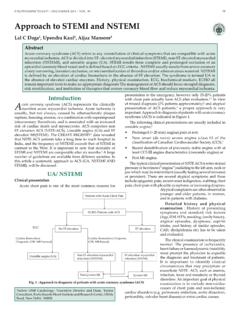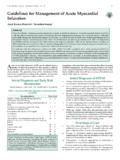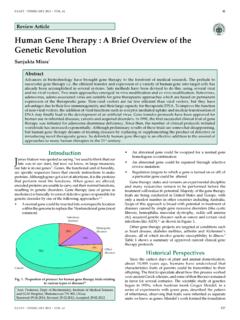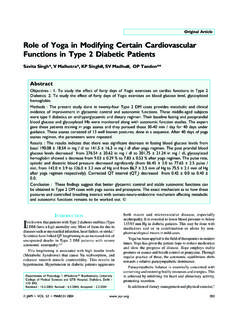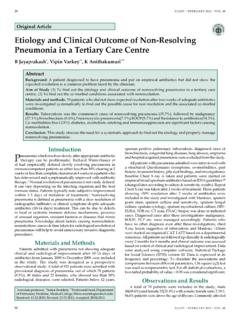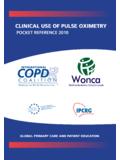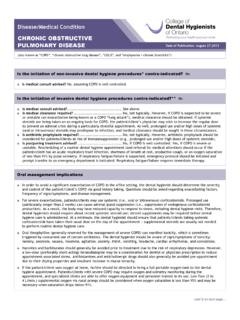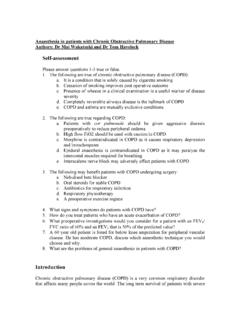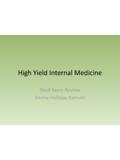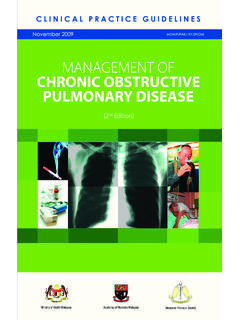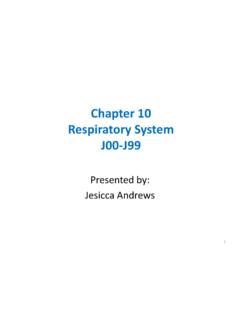Transcription of Treatment of Acute Exacerbation of COPD
1 38 SUPPLEMENT TO JAPI FEBRUARY 2012 VOL. 60 copd Exacerbation is a nightmare not only to all clinicians but also for the patients themselves. Despite adequate copd control, patients experience episodes of Exacerbation at times with a huge impact on the overall health condition, both physically and mentally. Moreover, copd Exacerbation incurs a huge cost and can cause significant dent in pulmonary function and the quality of life. It is therefore extremely important for practicing physicians to: Recognize the crisis early Perform optimal management under appropriate settings Escalate and de-escalate the therapy based on patient response Bring back the patient to the initial baseline status Help the patient and family to cope with the situation with adequate support Discharge the patient in a stable clinical condition Give necessary instruction about the proper follow up.
2 Definition1An Exacerbation of copd is an event in the natural course of copd characterised by an Acute change in the patient s baseline dyspnoea or breathing difficulty, cough and/or sputum production beyond day-to-day variability sufficient to warrant a change in cause can be infective or non-infective in of exacerbations1 In the absence of a universal agreed criterion, the following operational classification can help rank the clinical severity of the episode and its outcome. Level I : treated at home. Level II : requires hospitalization. Level III: leads to respiratory 50% of copd exacerbations are caused by lower respiratory tract infections, while the remaining are caused by exposure to indoor or outdoor air pollutants, changes in weather, Treatment of Acute Exacerbation of COPDAG Ghoshal1, Raja Dhar2, Susmita Kundu31 Director,National Allergy Asthma Bronchitis Institute, Kolkata 700017.
3 2 Consultant Pulmonologist, Fortis Hospital, Kolkata. 3 Associate Professor, Institute of Post Graduate Medical Education and Research, Kolkataand several host factors including prior compliance to Bacterial etiology in AECOPD varies, one study from India reporting Gram negative bacteria as the most common organism, which may not reflect the entire Another study from India stressed evidence of past pulmonary tuberculosis in of patients and active tuberculosis in 5 patients with Type II diabetes mellitus (Table 1).4 SymptomsSymptoms of copd Exacerbation includei. Increase in coughii. Increase in breathlessnessiii. Increase in sputum volume and change in its colour(white to green, yellow or blood streaked)iv. Fever v. Chest pain vi. Increased tirednessvii.
4 Increase in oxygen requirement (for those on long-term oxygen therapy)Usually patients present with varying combination of these symptoms. During clinical assessment, further objective evaluation is necessary. Several clinical elements must be considered when evaluating patients with exacerbations . These include the assessment of severity of underlying copd , the presence of comorbidities and history of previous Exacerbation . The physical examination should evaluate the effect of the episode on hemodynamic and respiratory systems. The diagnostic procedures to perform such as chest radiology, sputum and blood examination and spirometry would depend on the clinical setting of to treat5,6 The decision to treat a patient at home or hospital is based both on subjective evaluation as well as objective criteria.
5 The choice of the patient/patients` family should also be taken into account. Table 2 below offers a ready-reckonerHowever it must be noted that there may be a sudden deterioration of condition and the decision to treat at home or at hospital can change 3 shows the elements of the clinical evaluation and diagnostic procedures that are usually informative in patients with exacerbations according to the severity of the ,8 InvestigationsDiagnosis of an Exacerbation is primarily clinical and not so much dependant on investigation results though they are useful in assessing the severity and planning the optimum Treatment . The outline of the general investigation is provided in table careIn patients with an Exacerbation managed in primary care: Sending sputum samples for culture is not recommended in routine 1: Precipitating factors for AECOPDI nfectious processViral (Rhinovirus spp.)
6 , influenza); Bacteria (Streptococcus pneumonia, Haemophilus influenzae, Moraxella catarrhalis, Enterobacteriaceae spp., Pseudomonasspp.). Environmental conditionsSudden change in temperature and humidity, air pollution, exposure to tobacco smoke, noxious gases or irritating chemicalsHost factorsPatients with poor general heath condition, poor nutritional status, immunocompromised status, lack of compliance with prescribed medical therapy. SUPPLEMENT TO JAPI FEBRUARY 2012 VOL. 60 39 Table 2 : Factors to consider where to treat AECOPDF actorIndication to treat at homeIndication to treat at hospitalAble to cope at homeYe sNoSeverity of breathlessness MildSevereGeneral health conditionGood/SatisfactoryPoor/deteriora tingLevel of activity GoodPoor/confined to bedCyanosis NoYe sWorsening peripheral oedemaNoYe sLevel of consciousness NormalImpairedAlready receiving LTOT NoYe sSocial circumstances Good /adequate supportLiving alone/not copingAcute confusion/altered mental statusNoYe sRapid rate of onset NoYe sSignificant co-morbidity (particularlyheart disease and insulin-dependentdiabetes)NoYe sSaO2 < 90% NoYe sChanges on the chest radiograph NoPresentArterial pH level < PaO2 7kPa<7kPa Table 3.
7 Stratification of AECOPDL evel I (Treated at home)Level II (Requires hospitalization)Level III (Leads to respiratory failure)Clinical historyCo-morbid conditions #+++++++Frequent exacerbations +++++++Severity of COPDMild/ModerateModerate/SevereSeverePh ysical findingsHaemodynamicsStableStableStable/ unstableUse of accessory muscles while breathing/tachypnoea Not present+++++Persistent symptoms after initial therapyNo+++++Diagnostic proceduresOxygen saturationYe sYe sYe sArterial blood gasesNoYe sYe sChest radiographNoYe sYe sBlood tests NoYe sYe sSerum drug concentration*If applicableIf applicableIf applicableSputum gram stain and culture $NoYe sYe sElectrocardiogramNoYe sYe sKeys : + unlikely to be present; ++ likely to be present; +++ very likely to be resent; # the more common co-morbid conditions associated with poor prognosis in exacerbations are congestive heart failure, coronary artery disease, diabetes mellitus, renal and liver failure; Blood test include complete blood count, serum electrolytes, renal and lever function; * consider if patients are using theophylline, warfarin, carbamazepine, digoxin.
8 $ consider if patient has been recently on antibiotics Pulse oximetry is useful if there are clinical features of a severe referred to hospitalIn all patients with an Exacerbation referred to hospital: A chest radiograph should be obtained Arterial blood gas tensions should be measured and the inspired oxygen concentration recorded An ECG should be recorded to exclude cardiac co-morbidities A full blood count should be performed and urea and electrolyte concentrations should be measured If sputum is purulent, a sample should be sent for microscopy and culture Blood cultures should be taken if the patient has should be the outpatient management for copd Exacerbation ?The Treatment of Exacerbation has to be based on the clinical presentation of the patient, as shown in table I: Outpatient treatmentBronchodilators9,10 Short-acting 2-agonist and/or ipratropium by metered dose inhaler with spacer or nebuliser as needed.
9 Consider adding long-acting bronchodilator , formoterol (by MDI plus spacer or nebulised route) if patient is not using itDelivery systems for inhaled therapy during exacerbations Both nebulisers and hand-held inhalers can be used to administer inhaled therapy during exacerbations of copd . The choice of delivery system should reflect the dose of drug required, the ability of the patient to use the device and the resources available to supervise the administration of the ,12In the absence of significant contraindications, oral corticosteroids should be considered in patients managed in the community who have an Exacerbation with a significant increase in breathlessness which interferes with daily activities. Oral prednisone 30 40 mg per day for 10 days Consider using an inhaled corticosteroid 11 Antibiotics13,14 May be initiated in patients with altered sputum SUPPLEMENT TO JAPI FEBRUARY 2012 VOL.
10 60 Table 4 : Stratification of AECOPD with likely bacteriological profile and treatmentGroupMicroorganismsOral TreatmentAlternative Oral TreatmentParenteral TreatmentGroup AMild exacerbations : no risk factor for poor outcome Chlamydia pneumoniae Viruses Patient with only one cardinal symptom need not receive antibiotics If indication then : - -lactum (penicillin, ampicillin/amoxicillin) - Doxycycline - Trimethoprim/sulfamethoxazole. -lactum/ -lactamase inhibitor (co-amoxyclav). Macrolides (azithromycin, clarithromycin, roxithromycin). Cephalosporins (2nd and 3rd generations) Ketolides (telithromycin)Group BModerate exacerbations with risk factors for poor outcome Group A plus presence of resistant organisms ( -lactamase producing, penicillin resistant S.)
